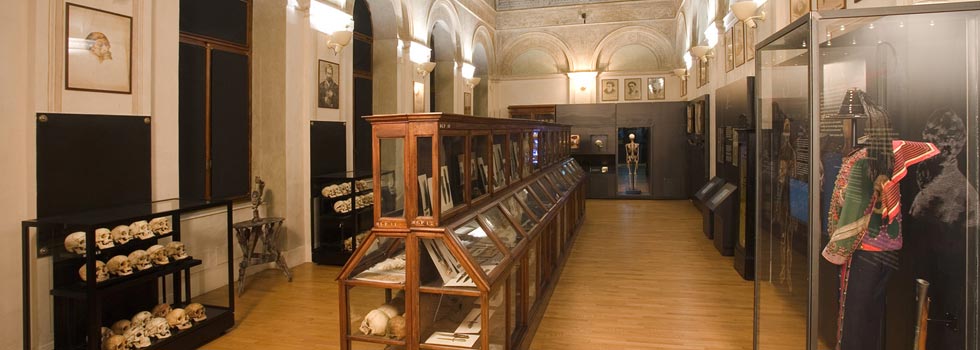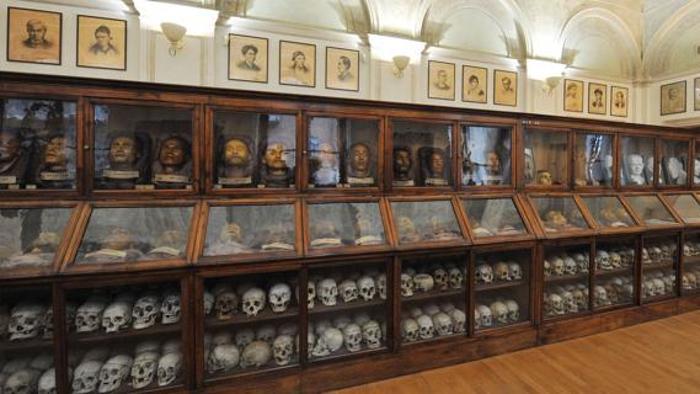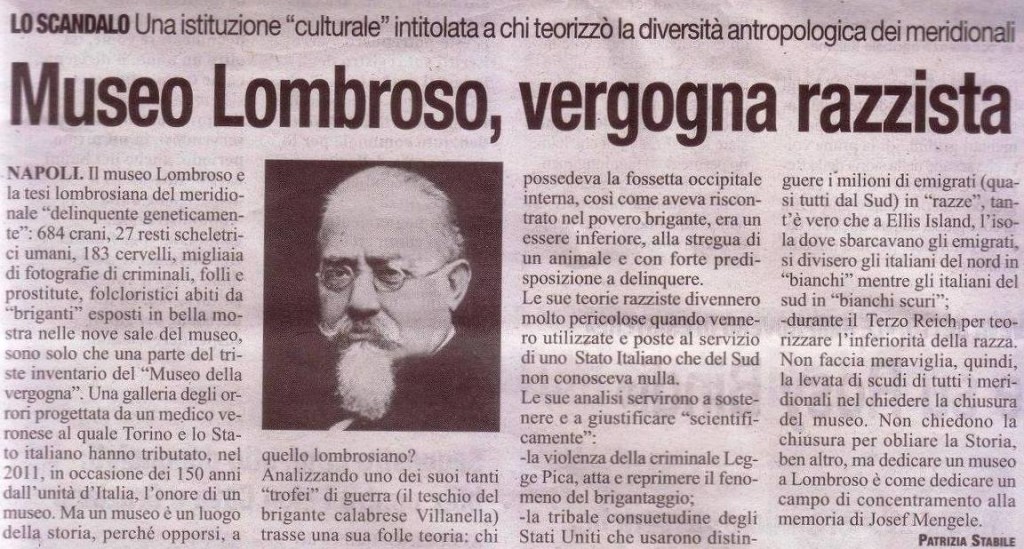Torino il Museo Lombroso

Il Museo di Antropologia criminale
Nel 2009, a cento anni dalla morte di Cesare Lombroso, fondatore dell’antropologia criminale, si è riallestito il “suo” museo, unico al mondo. Le collezioni comprendono preparati anatomici, disegni, fotografie, corpi di reato, scritti e produzioni artigianali e artistiche, anche di pregio, realizzate da internati nei manicomi e da carcerati.

Il nuovo allestimento vuole fornire al visitatore gli strumenti concettuali per comprendere come e perché questo personaggio così controverso formulò la teoria dell’atavismo criminale e quali furono gli errori di metodo scientifico che lo portarono a fondare una scienza poi risultata errata.
Il museo Lombroso divide il web: due petizioni opposte su change.org
Sulla piattaforma online si sfidano a colpi di firme quelli che ne chiedono la chiusura e coloro che invece la vogliono impedire

Il museo di antropologia criminale Cesare Lombroso è stato aperto a Torino nel 2009, a cent’anni dalla morte dello studioso
+ Torino si arrende “Il cranio del brigante ritorni in Calabria” Emanuela minucci
+ “Basta con Lombroso antimeridionale” EMANUELA MINUCCI
+ Il brigante Villella può restare a Torino Il caso Lombroso diventa internazionale ANGELO D’ORSI
+ Lombroso razzista? Noi non sposiamo le sue teorie
+ Il nipote di Lombroso: “Il mio bisnonno sbagliava, ma senza pregiudizi” Emanuela minucci
enrico forzinetti
La figura del medico e antropologo Cesare Lombroso e le sue teorie basate sulla frenologia e la fisiognomica fanno ancora discutere. Sulla piattaforma change.org sono state lanciate due petizioni: una per chiedere la chiusura del museo di antropologia criminale dedicatogli dall’Università di Torino, l’altra, nata in risposta alla prima, per impedirla.
Chi lotta per la chiusura del museo
Il Comitato No Lombroso ha sostenuto la prima petizione, lanciata da Alessandro Bello, nel nome di una lotta che prosegue dal 2009, anno dell’apertura del museo. «Contestiamo l’esposizione di resti umani collezionati in maniera illegittima da Lombroso. Chiediamo che questi siamo restituiti e poi sepolti- ha dichiarato Domenico Iannantuoni, presidente del Comitato- Poi, se lo vorrà, l’Università faccia pure un museo dedicato a Lombroso, ma con dei resti in suo possesso o con dei calchi».
Iannantuoni ha raccontato di aver raccolto attorno a sé movimenti meridionalisti che lottano contro il pensiero di Lombroso, ritenuto colpevole di aver teorizzato l’inferiorità del Sud Italia e dei meridionali. «Quello che vogliamo difendere è la dignità umana, un museo del genere rischia di riproporre le teorie razziste del Positivismo» ha concluso il presidente del Comitato No Lombroso.
Chi lotta per tenere aperto il museo
Finora la campagna per la chiusura del museo, lanciata il 17 settembre, ha raccolto oltre 9200 firme. A questa si oppone la petizione ideata da Chiara Ascheri per difendere l’esistenza del museo Lombroso, finora sostenuta da quasi 4000 persone.
La campagna è stata poi fatta propria dal museo stesso e dal suo direttore Silvano Montaldo, storico dell’Università di Torino. «Il museo rappresenta un pezzo della storia d’Italia ed è seguito in tutto il mondo. Non c’è alcun motivo di chiuderlo: la storia della scienza è costellata di errori. Il museo è l’esempio che ogni teoria è rivedibile»
Montaldo poi si è soffermato sull’accusa di antimeridionalismo mossa a Lombroso da coloro che vorrebbero la chiusura del museo. «Lombroso non si è mai scagliato contro i meridionali in verità. Il museo non può essere in alcun modo ritenuto la fossa comune dei meridionali come sostenuto dal Comitato No Lombroso. Si tratta di un’interpretazione senza fondamento e il libro di Maria Teresa Milicia Lombroso e il brigante lo spiega in maniera chiara».
La vicenda del cranio di Giuseppe Villella
Uno degli oggetti simbolo dello scontro tra chi contesta e chi difende il museo è certamente il cranio di Giuseppe Villella, brigante calabrese a partire da cui Lombroso avrebbe formulato le teorie sulla determinazione biologica del criminale. Interpretazione non condivisa dall’antropologa Milicia, secondo cui Lombroso non avrebbe mai analizzato il corpo dell’uomo.
La richiesta di restituzione del cranio è stata avanzata dal comune di Motta Santa Lucia, in provincia di Catanzaro, e accolta dal Tribunale di Lamezia Terme. A inizio 2013 la corte di Appello di Catanzaro ha sospeso però la restituzione dopo il ricorso dell’Università di Torino. Nello stesso anno il Consiglio comunale di Torino ha votato a favore di una mozione per la restituzione del cranio di Villella al paese di origine.
Sul caso del museo Lombroso si è anche recentemente espressa l’Icom (International Council of Museums) che ha sottolineato come il museo rispetti gli standard scientifici ed etici necessari per rimanere aperto.

The ‘born criminal’? Lombroso and the origins of modern criminology
Described as the father of modern criminology, Cesare Lombroso’s theory of the ‘born criminal’ dominated thinking about criminal behaviour in the late 19th and early 20th century
Submitted by: Emma Mason
Believing essentially that criminality was inherited and that criminals could be identified by physical attributes such as hawk-like noses and bloodshot eyes, Lombroso was one of the first people in history to use scientific methods to study crime.
Now, Lombroso is the subject of a new historical novel by former criminal barrister Diana Bretherick. Here, writing for History Extra, Bretherick tells you everything you need to know about Lombroso, and explains why his influence on today’s study of crime cannot be ignored…
It began in Italy in 1871 with a meeting between a criminal and a scientist. The criminal was a man named Giuseppe Villella, a notorious Calabrian thief and arsonist. The scientist was an army doctor called Cesare Lombroso, who had begun his career working in lunatic asylums and had then become interested in crime and criminals while studying Italian soldiers. Now he was trying to pinpoint the differences between lunatics, criminals and normal individuals by examining inmates in Italian prisons.
Lombroso found Villella interesting, given his extraordinary agility and cynicism as well as his tendency to boast of his escapades and abilities. After Villella’s death, Lombroso conducted a post-mortem and discovered that his subject had an indentation at the back of his skull, which resembled that found in apes. Lombroso concluded from this evidence, as well as that from other criminals he had studied, that some were born with a propensity to offend and were also savage throwbacks to early man. This discovery was the beginning of Lombroso’s work as a criminal anthropologist.
Lombroso wrote: “At the sight of that skull, I seemed to see all of a sudden, lighted up as a vast plain under a flaming sky, the problem of the nature of the criminal – an atavistic being who reproduces in his person the ferocious instincts of primitive humanity and the inferior animals.
“Thus were explained anatomically the enormous jaws, high cheek bones, prominent superciliary arches, solitary lines in the palms, extreme size of the orbits, handle shaped or sessile ears found in criminals, savages and apes, insensibility to pain, extremely acute sight, tattooing, excessive idleness, love of orgies and the irresistible craving for evil for its own sake, the desire not only to extinguish life in the victim, but to mutilate the corpse, tear its flesh, and drink its blood.”
Essentially, Lombroso believed that criminality was inherited and that criminals could be identified by physical defects that confirmed them as being atavistic or savage. A thief, for example, could be identified by his expressive face, manual dexterity, and small, wandering eyes. Habitual murderers meanwhile had cold, glassy stares, bloodshot eyes and big hawk-like noses, and rapists had ‘jug ears’. Lombroso did not, however, confine his views to male criminals – he co-wrote his first book to examine the causes of female crime, and concluded, among other things, that female criminals were far more ruthless than male; tended to be lustful and immodest; were shorter and more wrinkled; and had darker hair and smaller skulls than ‘normal’ women. They did, however, suffer from less baldness, said Lombroso. Women who committed crimes of passion had prominent lower jaws and were more wicked than their male counterparts, he concluded.
Inspired by his discovery, Lombroso continued his work and produced the first of five editions of Criminal Man in 1876. As a result Lombroso became known as the father of modern criminology. One of the first to realise that crime and criminals could be studied scientifically, Lombroso’s theory of the born criminal dominated thinking about criminal behaviour in the late 19th and early 20th century.
For thousands of years until that point, the dominant view had been that, as crime was a sin against God, it should be punished in a fitting manner – ‘an eye for an eye’, and so forth. During the Enlightenment, thinkers such as Jeremy Bentham the and Italian Cesare Beccaria decided that, as we were all rational beings, the choice to commit an offence was taken by weighing up the costs and benefits. If the costs were made high with harsh penalties then this would put off all but the most determined of criminals.
This was an interesting philosophy, but critics noted its flaws – not everyone is rational, and some crimes, particularly violent ones, are purely emotional, they said. Lombroso and his fellow criminal anthropologists also challenged these ideas, and were the first to advocate the study of crime and criminals from a scientific perspective. In particular, Lombroso supported its use in criminal investigation and one of his assistants, Salvatore Ottolenghi, founded the first School of Scientific Policing in Rome in 1903.
Throughout his career, Lombroso not only drew on the work of other criminal anthropologists throughout Europe, but also conducted many of his own experiments in order to prove his theories. These involved using bizarre contraptions to measure various body parts, and also more abstract things like sensitivity to pain and a propensity to tell untruths. Indeed, Lombroso eventually developed a rudimentary prototype of the lie detector.
Lombroso used various pieces of equipment for different purposes. A hydrosphygmograph, for example, was used to study changes in blood pressure in his subjects, who included criminals with long records of offending, and ‘normal’ subjects. While their left arm was attached to the machine and the right to an induction coil called a Ruhmkorff, subjects would be exposed to various stimuli – both unpleasant, such as electric shocks and the sound of the firing of a pistol, and pleasant, for example music, food, money, or a picture of a nude woman.
The problem was that the recording of the results was sometimes chaotic, which made the conclusions drawn unreliable, to say the least. To make matters worse, Lombroso tended to draw on unusual evidence to add weight to his theories, such as old proverbs, and anecdotes told to him by friends and colleagues over the years. This left his work vulnerable to attack by critics across Europe. All of this, perhaps, reflects the sort of man Lombroso was: capricious, ebullient and probably maddening to work for – although, one would imagine, never dull.
A familiar face
Lombroso was a well-known personality in Italy, giving sell-out lectures and talks, and commenting on all kinds of things in the popular press. He was interested in many things, and sometimes had difficulty in focusing on one thing at a time. One of his daughters, Paola, described a typical day in his life: “…composing on the typewriter, correcting proofs, running from Bocca (his publisher) to the typesetter, from the typesetter to the library and from the library to the laboratory in a frenzy of movement…; and in the evening, not tired and wanting to go to the theatre, to a peregrination of two or three of the city’s theatres, taking in the first act at one, paying a flying visit to another and finishing the evening in a third.”
Lombroso was endlessly curious about crime, criminals and their motivation for offending, as well as their culture. As a result, he collected artefacts created by and belonging to prisoners that he had encountered during his long career. He also had in his possession death masks from various criminals who had been executed, as well as many skeletons and skulls. Initially, these were housed at his home and then at the University of Turin where he worked. In 1892 Lombroso opened a museum for these artefacts. This closed in 1914, but reopened in Turin in 2010 and is well worth a visit. One of the most prominent exhibits was Lombroso’s head in a jar of preservative, which he agreed would be donated upon his death (in 1909).
An early sexologist
Lombroso’s other interests included hypnotism and the paranormal, particularly spiritualism. He has also been described as an early sexologist, given that he was one of the first to examine and catalogue sexual practices. His work Criminal Woman (1893) included sections on adultery, frigidity, lesbianism, masturbation and premarital sex, as well as a discussion on the causes and characteristics of prostitution.
According to Lombroso, his interest in the occult began when, in 1882, he was asked to examine the 14-year-old daughter of a family friend. She was thought to be suffering from hysteria and had been vomiting, sleepwalking and complaining of fatigue. Lombroso concluded this girl was able to see into the future and also to describe what others were doing when they were far away. She was apparently also able to see, read and smell with other parts of her body. Lombroso could offer no explanation for this.
Another famous example was what he described as the case of the haunted cellar. Here he was called in by a family of wine merchants who believed one of their wine cellars was under attack from invisible entities. When Lombroso visited, he went down to the cellar and waited to see what happened. Bottles began to fall and by the time he left Lombroso had witnessed 15 being broken. Again, he was unable to offer an explanation for what he had seen.
As well as breaking new ground in his work on criminals, Lombroso has also been described as a founding father of parapsychology [a pseudoscience concerned with the investigation of paranormal and psychic phenomena which includes telepathy, near-death experiences and reincarnation]. He investigated a psychic medium called Eusapia Palladino, participating in seances led by her. In one, which took place in 1892 and saw the medium tied to a camp bed, a number of spirits seem to have presented themselves. This persuaded Lombroso, among other witnesses, that the spiritual world was a reality, and he considered it a duty to establish beyond doubt (with the assistance of science) that ghosts were real.
Lombroso’s last book, published after his death, was a discussion of the biology of the spiritual world. Unsurprisingly it had a mixed reception, and his research into ghosts, poltergeists, telepathy and levitation appropriately disappeared into the ether. It did, however, add to the general discrediting of Lombroso’s ideas over the years, and for some time his work was viewed as being more of curiosity value than anything else. This was accentuated by the increasing popularity of eugenics and the use of biological theories of crime by the Nazis to justify the murder millions of people. In the postwar period other, more sociological, explanations for criminal behaviour became more popular, and thus biological theories were largely rejected.
However, in recent years bio-criminology has re-emerged, largely due to Lombroso’s legacy. He introduced the idea that criminality was not a matter of sin or free will, but could instead be a medical problem that needed to be examined by experts in that field. Lombroso also advocated examining the criminal as an individual rather than focusing on the crime alone.
In addition to his pioneering work on the female offender, Lombroso was one of the first to use scientific methods to study crime, and he inspired many others to do the same. Today, neuro-criminology draws on some of Lombroso’s theories to explore causes of criminal behaviour – examining, for example, whether or not brain injuries or genetic abnormalities can lead to criminality or whether violence can be caused by a clinical disorder. Recent studies have found that there may be a genetic origin for violent crime, and that personality traits including criminality can be deduced from facial features. The born criminal, it seems, might not be such a ridiculous idea after all.
Diana Bretherick is a lecturer in criminology and criminal justice at the University of Portsmouth, and the author of The Devil’s Daughters (Orion, 2015), which features Cesare Lombroso as a character investigating a series of abductions and murders while he begins his research into criminal women. Bretherick was a criminal barrister for 10 years before becoming an academic.
To find out more about The Devil’s Daughters, click here.
